Home in India, job in Bhutan: Border shutdown hits Assam workers
COVID-enforced ban on entering Himalayan kingdom results in loss of livelihoods for hundreds of daily wage earners on the Indian side.
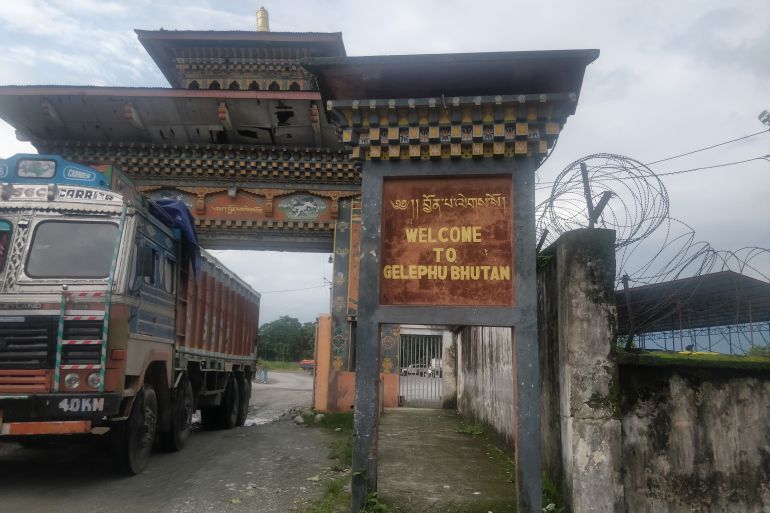
Chirang, Assam, India – As they inch closer to the towering gate at the India-Bhutan border in northeast India’s Assam’s Chirang district, murky water resting still in crater-like potholes awaits truckers trying to enter the tiny Himalayan kingdom.
The rest of the villagers, inhabiting Chirang’s thick green forests on the Indian side, are waiting for the borders to open again, as their lives come to a standstill after Bhutan sealed its international borders on March 23 last year over the coronavirus pandemic.
Keep reading
list of 4 itemsWhat is India’s new endgame in Kashmir?
Bhutan vaccinates 90 percent of adults against COVID in a week
After one COVID death, Bhutan king treks nation to stop another
Assam’s Chirang district shares a 70km (43-mile) border with Bhutan.
The ban on entering the kingdom resulted in the loss of livelihood for hundreds of residents in Chirang, who crossed the border legally to work as daily wage earners.
“Our lives have become stagnant. For the past 15 months, we have been struggling to find an alternative source of income,” Ram Hambron, 32, the village head man of Hatisar village in Chirang, told Al Jazeera.
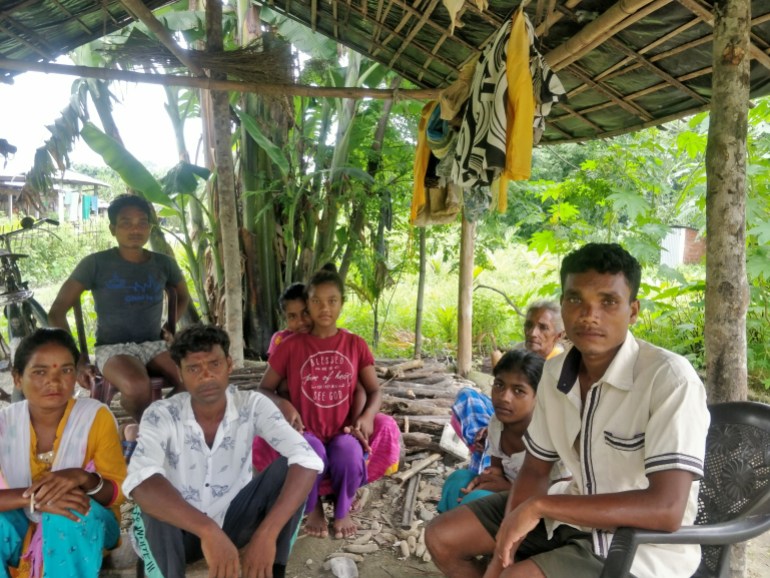
Hambron’s village is 2km (1.2 miles) from the international border, which he used to cross every day to work as a mason during the pre-pandemic days.
Economic hardships
While the potholes on the road ensure a bumpy ride, the empty eateries, lodges and shops along Gelephu-Dadgiri are testimony to the economic hardships of the people during the pandemic.
Not too long ago, the same place was a bustling bazaar. Everyday essentials and eatables enticed heavy footfall of patrons from both countries. The gate – or checkpoint, as the locals call it – painted in brick red and yellow has lost its sheen, too.
Now, a small queue of Indian truckers waits for the approval of the Royal Bhutan Police to enter the Himalayan kingdom to deliver essential goods.
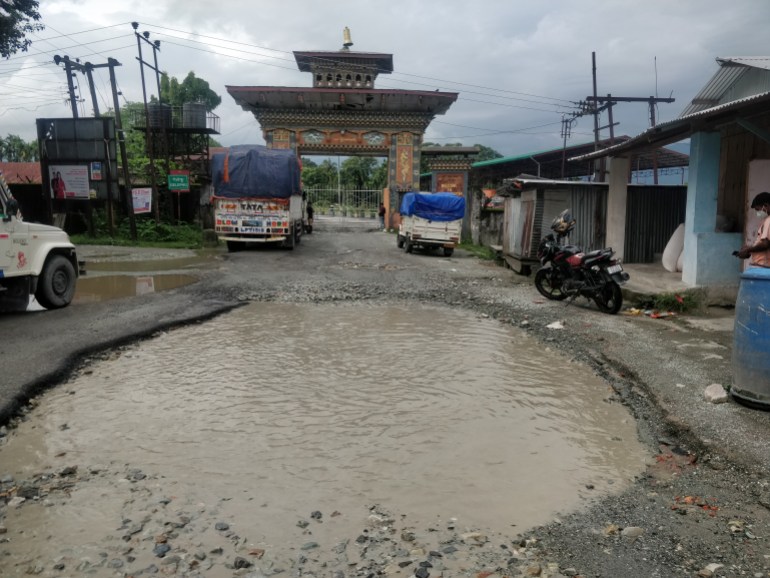
However, the residents of Dadgiri, a mini township, and the adjoining villages whose livelihood once depended on Bhutan have no such luck.
“We are all waiting for the Bhutanese government to allow us to enter the country and work,” Pranali Sutradhar, 30, a single mother of four children from Aie Powali-1 village, 3km (1.8 miles) from Dadgiri, told Al Jazeera.
“I have no work and have spent almost all my savings. I am worried soon I won’t have anything to feed my children,” Sutradhar, who used to work as a labourer in Bhutan, told Al Jazeera.
Her fellow villager, Prabhat Sutradhar, a mason by profession, is also jobless.
“I first went to Bhutan to work as an 18-year-old teenager. I worked there for seven years, almost daily, till the gate was closed for workers. Now I am unemployed and struggling to survive,” said the 26-year-old.
‘Tradition dating back to decades’
Like Pranali and Prabhat, at least one member from each of the 100 or so families in Aie Powali-1 have worked in Bhutan. The same applies to Hambron’s village, which has 45 Indigenous families.
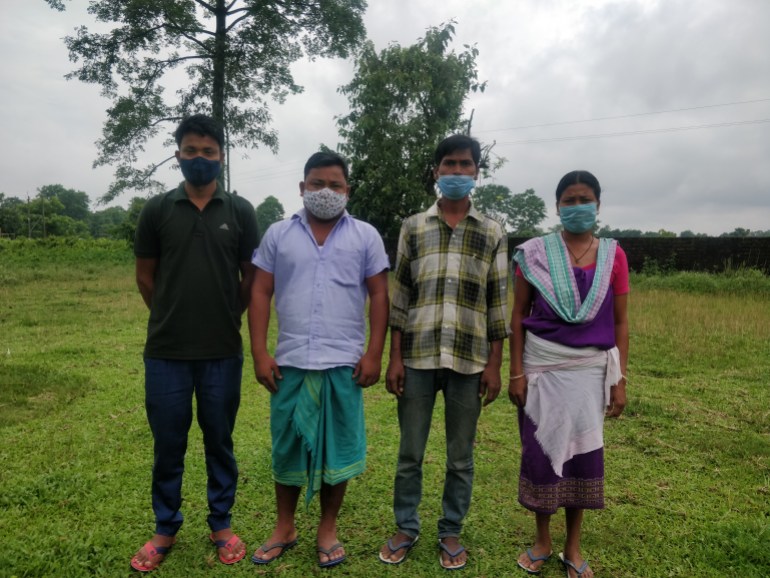
Before the pandemic, these villagers were working as construction labourers, masons, plumbers, welders and porters in Bhutan. Many also earned their livelihood by selling fruit, vegetables and woods in the Himalayan kingdom.
Every day they would cross the border – legally – and work from 9am to 4pm in Bhutan, collect their wages and return home to India.
All it took them was a daily token issued by the Royal Bhutan Police at the Gelephu-Dadgiri gate for the Indian workers to enter the country. No fee was charged.
Some of the most common work destinations in Bhutan were Gelephu, Thimphu, Tsirang and Sarvang.
“It’s a tradition dating back to many decades,” said Hambron, while talking about the daily crossing of the international border by villagers to earn a living.
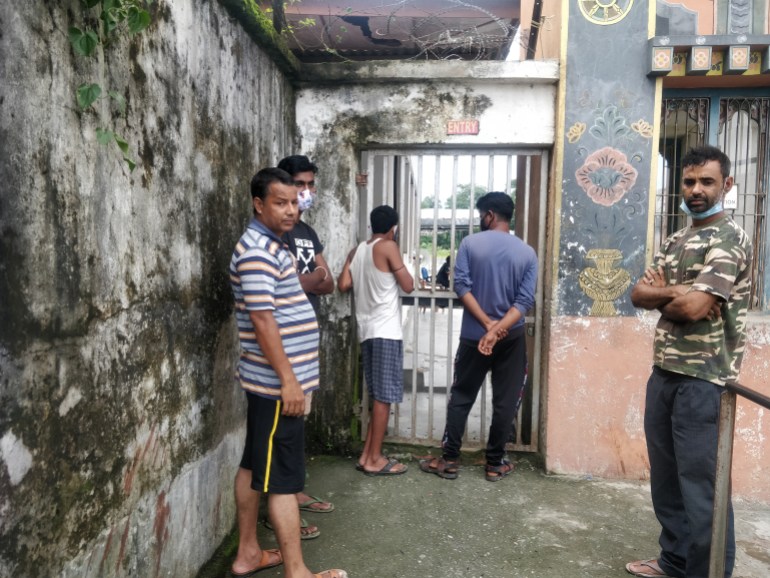
The workplaces in Bhutan such as Gelephu city, two to three kilometres (about 1.6 miles) from the international border, were closer to their villages than Kajalgaon, the district headquarters of Chirang, 45km (28 miles) away.
‘Bhutan kept the hearth burning’
The economy of about 120 villages in Chirang was heavily dependent on the earnings of its daily wage earners.
“It won’t be an exaggeration to say that Bhutan kept the hearth burning for the villagers,” said Rabindra Murmu, a local activist.
The only job left now, he added, is manual work. “These are mostly landless people and school dropouts. Since there was hardly any economic activity in the villages even during normal times, they went to Bhutan seeking work.”
The economic dependence on Bhutan – especially in Deosiri, Dadgiri and Shantipur areas of Chirang – could be easily gauged from the fact that the Bhutanese currency, the ngultrum, is still in circulation in these places.
When Al Jazeera met two friends, Mosey Murmu, 18, and Govind Murmu, 21, from Hatisar village, they showed the few remaining foreign currency notes tucked carefully in their wallets.
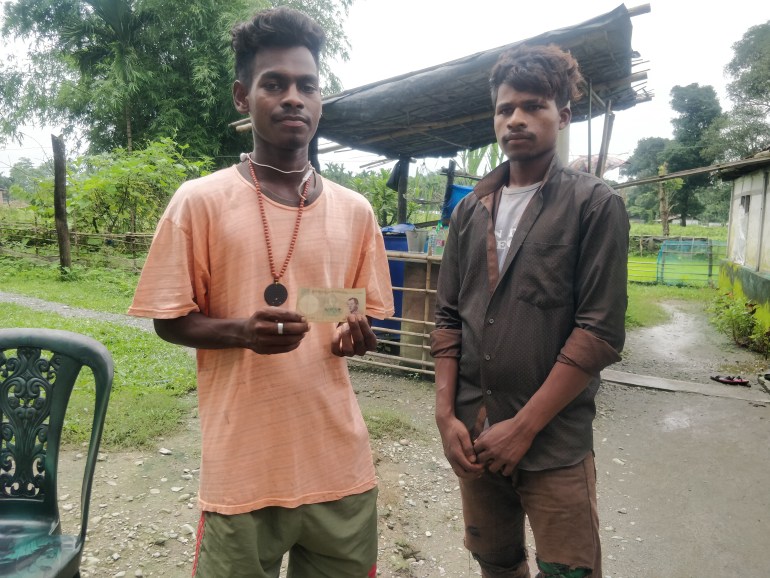
Both worked as welders in Bhutan and so did Mosey’s father. “It is a common practice here to use ngultrum for financial transactions,” said Govind.
When asked about ngultrum not being officially recognised as a legal tender in India, Govind smiled and said they earned in Bhutanese currency and spent it for their daily needs.
Now the friends are short on cash and they are worried about their future.
Bodoland bearing the brunt
Chirang is one of the four districts of the Bodoland Territorial Region or BTR of Assam state, which is divided into 33 administrative districts.
Since the late 1980s, the BTR region has seen a popular movement to create a separate state of Bodoland.
All the four districts of Assam’s BTR share an international border with Bhutan at various places – Saralpara in Kokrajhar district (40km or 25 miles), Darranga in Baksa district (90km or 56 miles), Bhairabkunda in Udalguri district (80km or 50 miles), besides Dadgiri in Chirang.
As Bhutan keeps its border closed, the rural population in all four BTR districts is facing economic hardship. Bongaigaon, which also shares a border with Bhutan, is the fifth Assam district to be affected by the closure.
They never tried to provide employment opportunities to the villagers and left them at the mercy of Bhutan. But we are not Bhutanese people. We are Indians.
The India-Bhutan border is 699km (434 miles) long. While Assam shares a 267km-long (166 miles) border with the neighbouring country, it also passes through three other Indian states: Arunachal Pradesh (217km or 135 miles), West Bengal (183km or 114 miles) and Sikkim (32km or 20 miles) respectively.
While villagers and local activists blame successive state governments of Assam for neglecting the area and its people, the officials maintain the area is a “cocktail of complexity”.
“We have to remember that the entire BTR was in the grip of violence and instability when Bodo militancy was at its peak. Peace has arrived in the area only in recent years,” divisional forest officer Brahmananda Patiri told Al Jazeera.
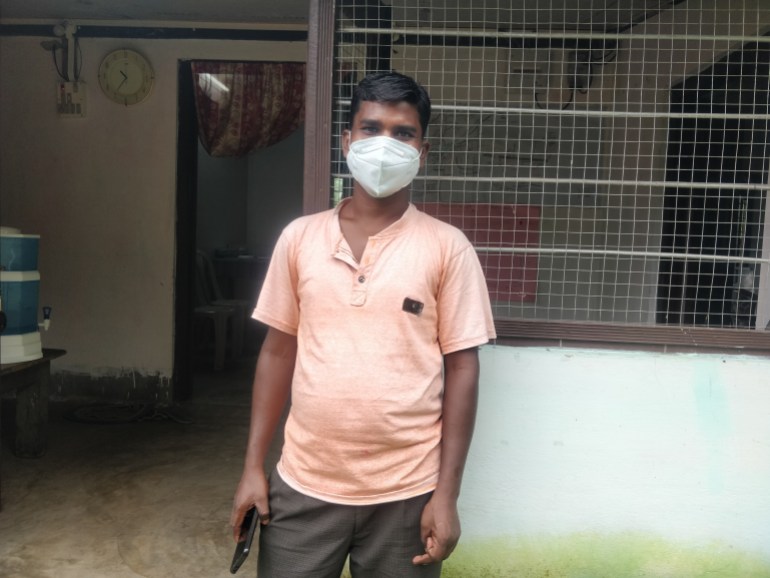
The region has also witnessed ethnic and religious violence in recent years. The tensions, Patiri said, not only created instability in the region but also prevented developmental projects from reaching the inhabitants, especially in rural areas.
Patiri said the population in the villages is diverse and comprises of the Bodos, the Indigenous tribes, native Assamese and even Nepali-speaking people.
“Villages here are not self-sufficient. There is no economic or agricultural activity. The whole area is not suitable for traditional agriculture such as paddy cultivation. The groundwater level is also low. Most of the people are settlers and victims of ethnic violence. They own very little land,” he said.
According to Pasang Chetri, a gender rights activist from the area, the state government never looked into the problems faced by people in such areas.
“They never tried to provide employment opportunities to the villagers and left them at the mercy of Bhutan. But we are not Bhutanese people. We are Indians,” he said.
The pandemic, Chetri said, has exposed decades of neglect by the state government.
“Most of the villages in Chirang district are remote and lack basic facilities like health, education and proper roads. Because of rampant poverty, cases of domestic violence and trafficking are also rising in the area,” he said.
Chetri said a survey conducted last month showed 16 children have gone missing along the border area. “We fear they were trafficked. There will be more such cases,” he said.
But officials such as Patiri say the government is trying. “Plans are afoot to train these villagers and engage them in sericulture, fishery and horticulture. In three years, we hope to provide economic independence to the villagers,” he told Al Jazeera.
Until then, villagers along the border are forced to pin all their hopes on Bhutan to open its gate for them. But Deepak Powrel, an official of the Royal Bhutan Police at the Gelephu-Dadgiri border gate, is not optimistic.
Powrel, who declined to be photographed but agreed to speak with Al Jazeera at the vehicle registration counter, said 70 trucks from India were allowed to enter daily.
“But opening the gate for all seems unlikely in the near future because COVID cases are not decreasing in India,” he said.